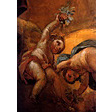
The Adoration of the Name
of God on the cupola
of the coreto of the Basilica
del Pilar (Zaragoza)







 |
Between May and the beginning of June 1772, Goya painted the fresco on the cupola of the coreto (little choir) del Pilar, opposite the Holy Chapel of the Virgin.
The Adoration of the Name of God, his first important work after his return from Italy was his attempt to confirm his artistic status in Zaragoza. Goya demonstrated what he had learnt in the churches in Rome and from the great decorations of masters of the Baroque and Rococco styles, from Giovanni Battista Gaulli il Baciccia to Sebastiano Conca and Corrado Giaquinto. The work consists of a celestial scene in which groups of angelic singers and musicians glorify the Name of God, represented by the name in Hebrew within a triangle, symbol of Complete Perfection. The cherubim at the extremes of the painting close the composition and lead the eye to the background. The yellow, golden and pink skies fall within the Roman-Neapolitan Rococco tradition. See:Arturo Ansón |
|
| Adoration of the Name of God or The Glory |  |
|
| Adoration of the Name of God or The Glory (Detail) |  |
|
| Adoration of the Name of God or The Glory (Detail) |
 |
InfoGoya 96 is an initiative of the University of Zaragoza, sponsored by the Institution Fernando el Católico of the Deputation of Zaragoza on an Apple Internet Server donated by Apple Computer. |    |